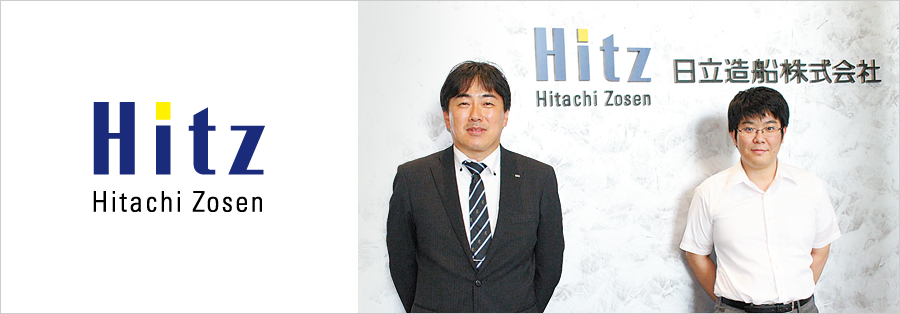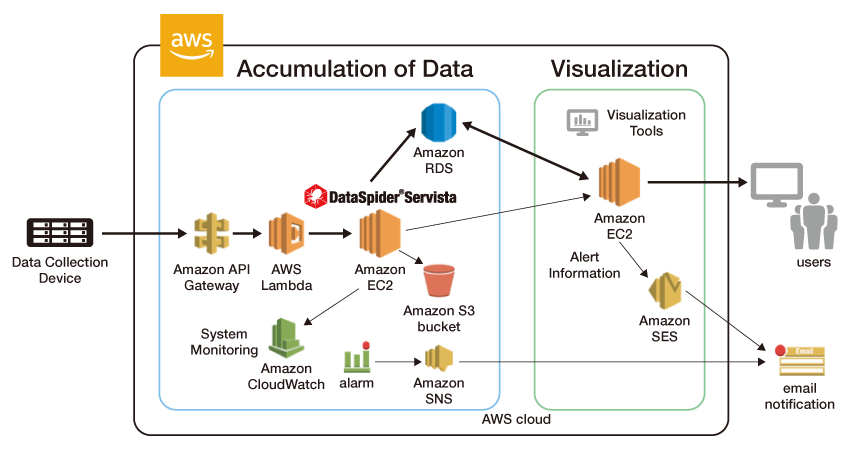Hitachi Zosen Corporation Using DataSpider

With DataSpider, Hitachi Zosen built an IoT platform in one month
Originally founded as Osaka Iron Works by Mr. E.H. Hunter in 1881, Hitachi Zosen creates earth sustainability products that range from energy-from-waste plants and water treatment facilities for the environmental plant business; to energy-efficient marine engines and presses for the machinery business; and facilities such as shield machines and bridges as part of the social infrastructure business.
To further worldwide sustainability and recycling goals, Hitachi Zosen made a commitment to focus on products related to energy and water. Part of the effort involved the creation of the Hitz Advanced Information Technology Center, which spearheads activities for the remote monitoring of equipment assets and infrastructure by using IoT technology and big data analysis of environmental plants, machinery, and social infrastructure.
The IoT monitoring and data collection performed at Hitz can monitor a plethora of different equipment assets and infrastructures from many diverse industries, platforms and applications. However, to facilitate this monitoring, Hitachi Zosen needed to find a data processing and integration software solution that was able to collect and process IoT data from a multitude of sources, applications and industries.
Finding a universal IoT data integration platform that could scale
 Mr. Hiroaki Yamada
Mr. Hiroaki YamadaManager, IoT System Section,
Information and Communication Technology Business Promotion Department,
Hitachi Zosen Corporation
“It was a challenge to find a data integration software that could work with and scale to virtually any kind of IoT application, since we had many different clients from a diverse set of industries,” said Hiroaki Yamada, manager of Hitachi Zosen’s IoT System Section in the Information and Communication Technology Business Promotion De-partment.
“To meet our business requirements, we initially selected Amazon Web Services (AWS) as our platform for data collection. We soon discovered, however, that we needed a tool that would allow us to process the collected data according to its purpose, which could vary depending upon the industry and application we were working with. We then had to pass this data along to a variety of different data visualization tools and databases. In order to accomplish this, we needed a tool that would allow us to simplify our process of specifying data settings and destinations, with no need to build in new functions ourselves,” said Yamada.
Hitachi Zosen’s IoT System Section went back to the drawing board with an evaluation of several other ETL tools.
“DataSpider allows data processing to be implemented with no need to perform programming,” said Mr. Yamada. “This was very attractive because it eliminated the need for us to do this programming ourselves. DataSpider was also able to fill the role of the type of simple and straightforward data processing platform we had in mind, because it provided very intuitive GUI-driven operations.”
For Hitachi Zosen, real time data collection was critical and DataSpider made it easy because it supported AWS and also provided many triggers for data collection and publication.
“We were also impressed with the abundance of different data script trigger functions that DataSpider offered,” said Mr. Yamada. “These functions gave us enormous flexibility in our data operations. For example, we could execute a script when a file was stored in a designated folder, and still maintain a high degree of compatibility with AWS.”
DataSpider provides flexibility and supports different data formats
The processing of IoT data that Hitachi Zosen collects begins with many hundreds of data items that are sent to AWS via a gateway that is integrated with a programmable logic controller (PLC). The PLC controls filtration devices called filter presses that are manufactured by Hitachi Zosen. From here, the data is sent to DataSpider, which organizes the data in formats that are appropriate for the systems (e.g., Amazon S3, Amazon RDS) that the data interfaces with.
As part of the process, Hitachi Zosen also uses a mechanism that sends urgent data, such as alerts, directly from DataSpider to data visualization tools and to system administrators.
 Mr. Jun Yokota
Mr. Jun YokotaIT Engineer, IoT System Section,
Information and Communication Technology Business Promotion Department,
Hitachi Zosen Corporation
“What really added value to our operation was the fact that we were able to use DataSpider to store data in different formats that were created and updated at different times and on different schedules, without a heavy burden on the people in charge,” said Jun Yokota of Hitachi Zosen’s IoT System Section.
“Even when we are monitoring the same machine, the sensor data varies for each customer. Because of DataSpider, we are able to flexibly handle this data by only specifying settings, even in environments that differ from one another. We could not have con-structed such a mechanism in such a short time if we had done the work manually,” said Yokota.
By using DataSpider, Hitachi Zosen was able to construct its IoT and analytics platform in only one month. “DataSpider was extremely easy to use, and it didn’t have a steep learning curve,” said Yokota. “We were able to complete the project quickly. We also discovered that the product could be used to specify data settings without any depend-encies or requirements to customize settings for the assortment of work environments that we operate in.”
Hitachi Zosen’s project team additionally found that by using DataSpider‘s specification-document creation function, scripts, icons and variables could be reused throughout the entire project. This eliminated repetitive “do over” processes, and reduced the risk of introducing errors.
“It is always advantageous when you can reduce the number of tasks in a project that depend on the skills of specific individuals,” said Yokota. “It also makes it easier for our employees to pass along responsibilities to their successors.”
Skills transfer is further facilitated by the many sample scenarios that DataSpider provides for specifying settings. “The sample scenarios are helpful, because they make it easier to gain a clear idea of the processing, especially when you are performing these tasks for the first time,” said Yokota.
Future platform evolution
“DataSpider’s flexibility gives us the potential to create new avenues of added business value for our customers and ourselves,” said Yamada. “By using DataSpider as a key element of our IoT platform, we will be able to integrate new types of mission-critical system data such as maintenance data and parts inventory information. In this environment, advance processing will be necessary to perform data analysis. We expect to be able to utilize DataSpider for that as well.”
Customer Benefits
- The creation of a scalable IoT platform in just one month
- Data processing without programming knowledge through an intuitive GUI
- Ability to store data in different formats without a heavy burden on IT

Notes:
- HULFT and other products related to HULFT are registered trademarks or trademarks of Saison Information Systems Co., Ltd.
- The company names and product names mentioned in this document are trademarks or registered trademarks of their respective companies.
- Trademark symbols (TM, ®) might not be appended to the system names, product names, etc., mentioned in this document.
